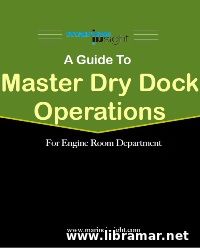 A very useful publication prepared by the MarineInsight team. The volume is intended to provide readers with the guidance related to the drydocking operations for the machinery room department of the vessels. Usually, the vessel is drydocked with the purpose to conduct periodical surveys of the underwater part of the hull, carry out major conversions, repairs and modifications that cannot be done while the vessel is afloat.
The present document will give some answers to the basic questions relating the drydocking. Successful completion of the drydocking activities will definitely require careful planning and following all procedures and leaves no room for mistakes. Should the planning be done wrong, drydocking can turn into a real nightmare for every crew member. The book opens with the section explaining in general what drydocking is and how and when it is performed.
The second section advises the basic steps to be done to plan the drydocking properly, while the third section is devoted to the crew members involvement. Finally, the closing section of the guide addresses how office supporting personnel are normally involved in drydocking. As you see, a good teamwork is necessary for the successful drydocking.
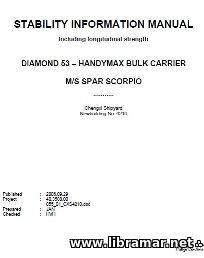 A real ship stability information manual of the Diamond 53 which is the handymax sized bulk carrier design. The document will serve as an excellent reference source when used for training purposes by the people learning how to develop a good stability manuals and understand typical arrangement of the paper. The document starts with the general introduction providing instruction to the ship's Master.
Then the information comes related to the main particulars of the vessel, definitions used throughout the document and conversion table. The next major part of the manual contains necessary information about the stability of the vessel, free surface effect, proper use of the data tables, visibility and air draught, draught/trim calculations, ship displacement, hydrostatic data, stability curves, stability criteria, ballast water exchange info, calculation of load and strength, and other important aspects.
The rest of the chapters in the manual provide tank capacity information, ship loading conditions, distribution of the lightweight, working examples, stability data including KN and MS tables, max KG and min LM limits, inclining test and other information. All relevant drawings are also included together with the loading conditions.
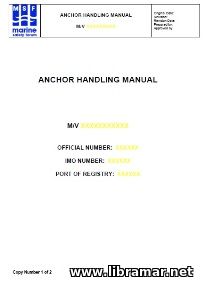 The template to be used when preparing the anchor handling manual. The content of the manual shall be read and duly understood by all crew members who are either indirectly or directly engaged in any rig mode and towing activities. Special attention shall be paid to the stability of the ship and emergency procedures. The content of the template was developed by the specialists of the MSF, standing for the Marine Safety Forum.
It starts with the document description and information plus the revision status - this is the first page leading to the main content. The Manual is specifically intended to provide all required guidance for safe anchor handling activities conducted on board the vessel. It should be read and used together with the procedures established by the Company as well as relevant international guidelines and other procedures commonly provided by the charterers of the vessel. The anchor handling normally implies special marine operations.
Noting the high tensions that are experienced in the wires and chains we may expect high heeling moments; another consequence may be transverse/astern movements of the AHTS. In addition, the motion of the vessel may also get affected by the hauling speed of the winch or other factors such as the loss on the bollard pull... The content is arranged in several sections covering anchor handling operations, bollard pull calculations, procedures to be used for anchor handling and towing, risk assessment and stability calculations winch details, emergency procedures etc.
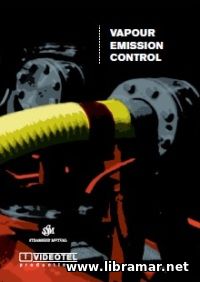 The present official training is aimed at the Masters and deck officers as well as senior engineers of the oil and chemical tankers, i.e. vessels considered subject to the VEC, i.e. vapor emission control. It supplements the video training devoted to VEC.
The declared learning objectives are to provide trainees with due understanding of the importance of VEC and with the good technical knowledge of the VEC systems that are commonly installed on such vessels, the layout of these systems, associated equipment and effective protective mechanisms. The trainees who go through both this booklet and video training will be able to operate the VEC system is a safe and efficient manner and will become thoroughly familiar with the applicable regulations and requirements.
The arrangement of the material in this booklet is similar to the one of the video - it opens with the introductory information followed by the several chapters addressing operation and training, procedures before arrival and loading, and after loading the cargo, lightering issues and others. there is a short glossary for easy use, and some questions for self-assessment. The appendices provide checklists to be filled prior to the use of the VEC system, and also sample VOC Management Plan for reference.
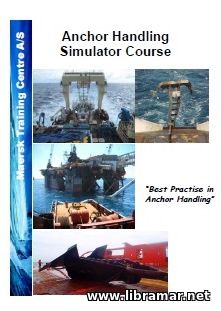 The aims and objectives of the present anchor handling course developed by Maersk is to promote the safest and most efficient ways of performing anchor handling operations by means of enhancing the knowledge and skills of the bridge teams.
The material include abbreviations used during the course, introductory part, calculations, examples of anchor deployment, various anchor handling equipment explained in detail, ship handling and maneuvering techniques, drilling unit operations and many more.
Taking into account that the main content was prepared by the Maersk specialists, we would highly recommend this training to all people directly engaged in planning or actual performance of the anchoring operations offshore.
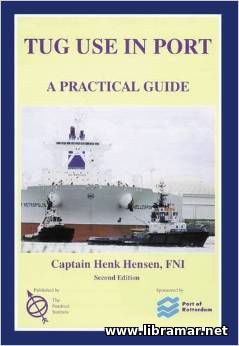 When vessels are assisted by tugs, the experience and teamwork, communication and above all insight into the capabilities and limitations of ships and attending tugs are considered essential for the safe and efficient shiphandling. This first of all applies to the captain and crew of the tug plus to the master of the vessel and pilot, especially today when older tugs are replaced by new tugs of modern types featuring much larger engine powers and significantly increased capabilities.
Reputable shipyards build good tugs, and designers can predict how well their tugs will perform. However, they do not handle ships themselves and have not experienced the tug assistance required: not in a river, channel or port approach nor in a confined harbor basin, not during a storm or in strong currents nor in the middle of a foggy night. Not even during nice, calm weather. These are the situations and conditions in which pilots and tug captains have to handle ships.
So it is essential that they know what can be expected from a tug in any specific circumstance. Only when these professionals are fully aware of the capabilities and limitations of the various types of tugs in general and of an individual tug, including the effects on an assisted ship, are they able to utilize tugs in the safest and most effective way and in harmony with a ship's maneuvering devices
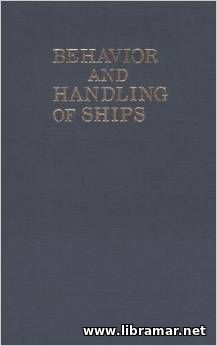 If you want to get a clear understanding of all possibilities of the big oil tankers as well as of all limitations imposed on them, you should definitely have a chance to try them out with no risk. And the Shiphandling Training Center located at Port Reve, in France will provide you with such a brilliant opportunity.
This is a place where a whole fleet of model tankers scaled 1:25 is being operated on a lake. It should be noted, however, that not only do vessel models offer this chance of handling scale replicas of the huge tankers under various conditions; the center also offers quite instructive overall view on the different maneuvers in a protracted time.
As a result, there is a lot of shiphandling operations conducted in this miniature world in a relatively short time, is five times faster than they would be in real life conditions. While the author of this book was observing the maneuvers on the lake analyzing them, it became quite clear to him that the positions of the pivot point plays a critically important role in explaining the vessel's behavior.
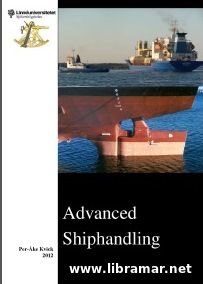 The experienced seaman and ship designer know just what the sea at its worst can do to the structure of a ship. Overwhelmed by the sea is a warning to both seafarer and architect that such unforgiving force must never be underestimated, and may not yet be fully understood. Let us look at a large cargo ship on a winter passage across the North Atlantic from Europe to North America.
Her Master will have received regular weather reports and will have plotted his route in an effort to minimize the effects of heavy weather, but such is the depth and frequency of the giant depressions that remorselessly track across the Western Ocean in winter, that it is unlikely that he can avoid their effects entirely. Sooner or later the ship will find itself laboring against the worst that nature can throw at it.
It is on such occasions that the complex structure of steel and systems which make up the modern ship will be tested to the limit. While the Master can adjust his speed and course to minimize the effects of the storm, his job is to get to his port of destination without too much delay, balancing the risk of damage against the cost of a late arrival, trusting in his skill as a ship handler and the strength of his ship.
« 1 2 ... 8 9 10 11 12 ... 14 15 » |







